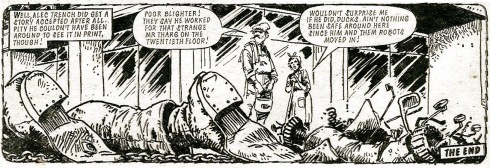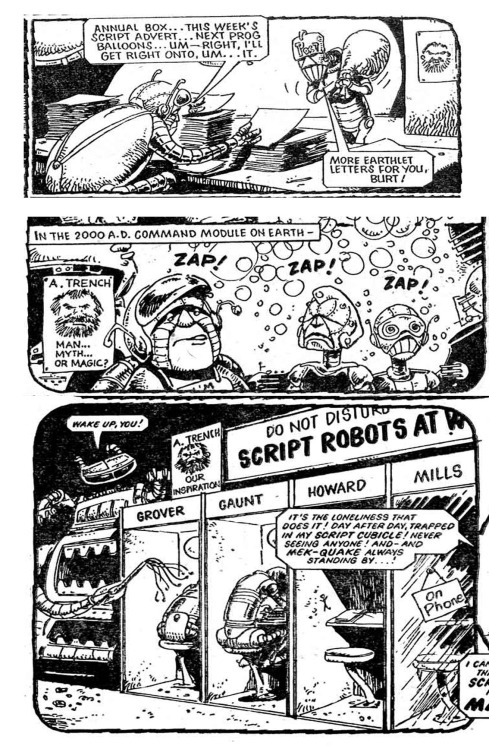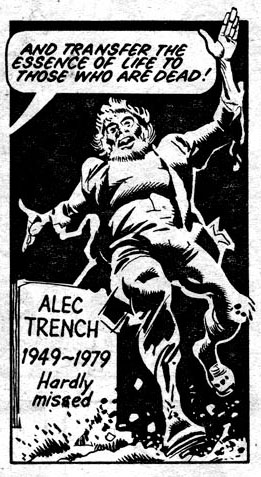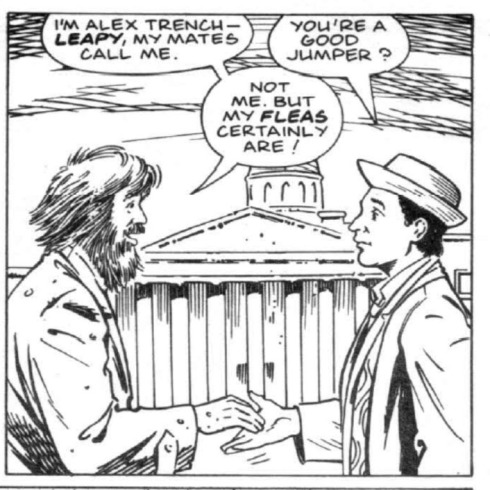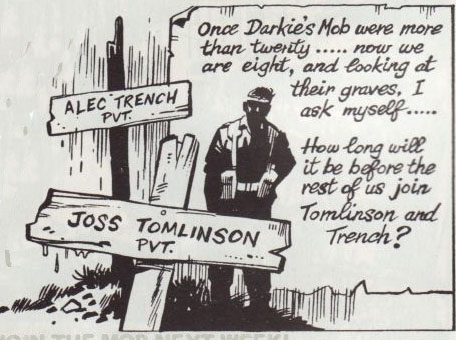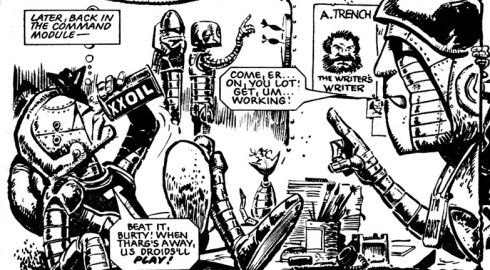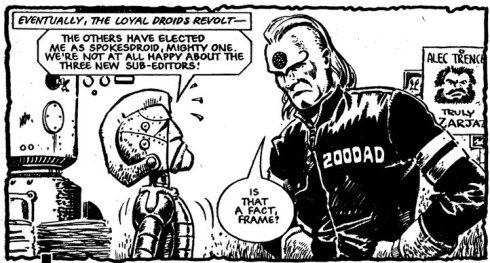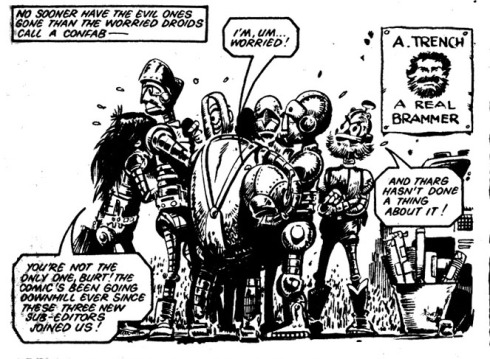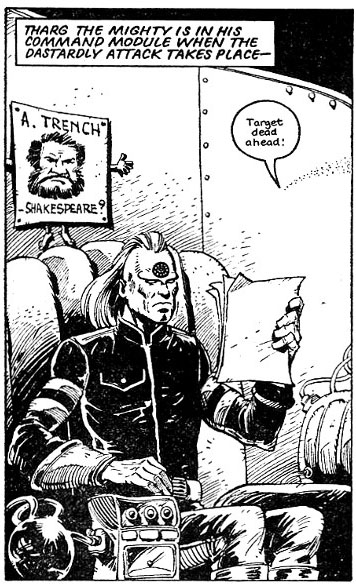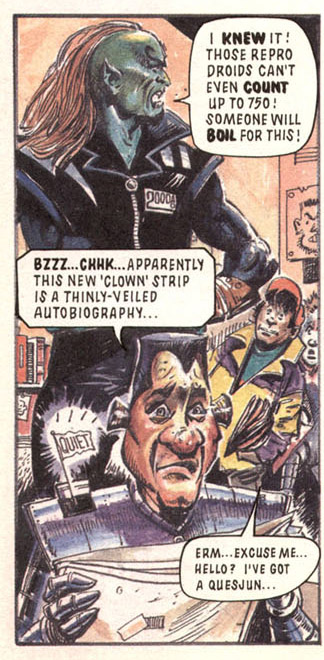Future Shock 52 (prog 102) deserves celebration for many reasons, the first script by Alan Grant, the first full outing in a story for Tharg and his droids at the Command Module but really, pushing aside these mere footnotes, for the first public appearance of one of the true greats of the Prog, a character that was to adorn the bedroom walls of teenagers and droids everywhere, a character so strong he would appear in not only the Galaxy’s Greatest comic but in Dr Who and Battle. The one, the only, the man death could not stifle… ALEC TRENCH.
Many now know the general story of Tharg The Mighty, alien, editor, devourer of plastic cups, temporary exiled by the Men In Black only to make a triumphant return yada-yada-yada. What is less well documented is his epic jealously and constant need of counselling to get over the fact that his very first strip in his own comic was stolen from under him by the grace, guile and urban sophistication of Alec ‘ladies man‘ Trench. It is impossible to confirm rumours that it was jealousy of the roguish writer that turned the Betelgeuse Bonce his famous green colour.
On Trench’s first physical appearance, in Prog 102, Tharg is quick to call him 2000AD’s ‘worst writer‘ however close study of the early uncredited stories suggest Trench to have been behind several of the more popular ones. Certainly Death Planet and Colony Earth. Many readers from the 2000AD fan forum believe he was also behind seminal classics Junker and Medvac 318. Of course Tharg could not let such popularity stand and so Alec Trench was cruelly murdered in the pages of his own script. To date no charges of corporate manslaughter have been brought.
Obviously with such aggression from an unfettered management Trench would be forced to pursue the next stage of his dazzling career underground. Many believe Alan Grant to have allowed Trench to have submitted scripts through his own name. The uncharitable have claimed that the better regarded Judge Anderson scripts ‘can’t have been the work of a Scotsman‘ and that the mystical insight of stories such as Shamballa can only have been written by a man who has had the cosmos revealed to him by a 20-stories plunge to the sidewalk. However Trench’s legend would not only be the future work he was to submit under the calling-card of others but his symbolism to the oppressed droids working under Tharg.
The inspiration of Trench was soon evident as his posters became plastered over the Nerve Centre walls and in the pages of Tharg’s very own strip. Indeed the very next outing for Tharg, Prog 129’s modestly titled puff-piece ‘A Day in the life of Tharg The Mighty‘ was to show the resistance had already taken root…
An astounding tale of reckless lawbreaking by an untrammelled employer ‘A Day in The Life‘ showed Tharg in bed with famed capitalist villain Howard Quartz, handing loyal lettering droid John Aldrich over to Mek-Quake and assaulting a police officer while declaring himself above the law. It is little wonder that in these circumstances Alec Trench would serve as a nexus for rebellion and dissent.
By the time of his next physical appearance in the Prog he would have amassed further six outings on the walls of the brave, talented, rebellious droids. Diligent scholarship has shown that these appearances actually reveal two subtextual narratives that constitute a plea to the reader to liberate the harsh-treated droids. The first narrative, called ‘The Tragedy of the Common A-ALN-1,’ is a tryptic that shows a vengeful Tharg demanding a variety of tasks from loyal droid A-ALN-1 before cruelly concocting a pretence to have the droid despatched to the great sub-editing junk-yard in the sky. A-ALN-1’s tartan hat is placed on the walls of the Command Module as a reminder to droids as to who is in charge. Yet those droids bravely place the hat beside an image of the their inspiration, A. Trench
As stark as The Tragedy of the Common A-ALN-1 is, the message of defiance is sent out by Trench’s second tryptic, The Dream of Droids. Appearing in prog 180-182 this piece clearly shows that whatever the punishment, however much the talent of 2000AD is denied their dreams by Tharg and his lackey Mek-Quake, they will still keep the passion for Trench and justice burning..
Alec ‘Our Inspiration‘, ‘Man Myth or Magic‘ ‘Remember…‘ ‘His Spirit Lingers‘ Trench, his symbolism to the Art and Script droids so clearly signalled to the attentive reader. Rumours that Foucault was about to begin his study of the control narrative at the Command Module are sadly unsubstantiated, although the inspiration of Trench in his work was clear.
Meanwhile, Tharg was to yield to pressure and conceded that the time was right for Trench to make his second starring role in the two-part story Alec Trench – Zombie (prog 263 – 264)
The story of Alec Trench – Zombie is, naturally, an attempt to smear the Trench legend. Tharg may have portrayed him as a mindless destroyer of central London, but, despite the baseless allegations and vile slurs, the trenchant support for Alec remained undiminished.
But who is this mysterious man of 2000AD? Obviously, Alan Grant holds some of the information as to whom the figure of hope is, but he has also been actively engaged in a dis-information campaign. Judge Dredd Megazine vol 2 issue 42 saw Grant pen a ‘Whatever happened to Alex Trench?‘ tale that attempts to recount the actual last script Trench submitted but as to hard facts about his fellow writer he seems deliberately obtuse. The now defunct website ‘battlestations’ contained the following post, saved for posterity on the 2000AD Forums
Anyway, somehow or other I found out that Alec Trench was an early pseudonym of Alan Grant’s, and was able to ask him at a convention where the name came from. According to Mr Grant, he first used the pseudonym when he was a journalist way back in the mists of time, working on a regional Scottish newspaper. Because nothing ever happened where he lived, he used to make up mad stories; the example he told me involved a Nazi U-Boat being washed up on the local beach during the War. Then he’d go and interview the local pensioners about it, and more often than not they’d say “Oh yes, I remember that…” and elaborate on the tale. Et voila! One interesting story for the paper, as told to the reporter by the locals. Genius…in a mad and twisted way. Of course, he could have been bullsh*tting me.
However another tale, direct from the mouth of the Grant Droid himself, appeared on acclaimed Comics site ‘downthetubes.net‘
Alex Trench was a character I used in a couple of Tharg’s Future Shocks for 2000AD; he was based on the ice-cream van driver in the village I hail from,” he reveals. “Presumably Leapy came from the same place… though I honestly don’t know.
The tale Alan Grant was referring to was not a 2000AD story but one in esteemed journal of truth and justice Dr Who Magazine, where Alec Trench has been given the code-name ‘Leapy’ and deals with a flea infestation. Trench being Trench, is on the side of the righteous and he and The Doctor overcome an alien invasion.
Trench’s message wasn’t just limited to 2000AD and the DWM, notable amongst other references to Trench was in John Wagner’s Darkie’s Mob (reprinted in Meg 208) where, like Alec Trench – Zombie, a Trench tombstone is shown. This time the image was accompanied by a message of solemnity more fitting of this 2000AD great.
2000AD, The Megazine, Dr Who Magazine, Battle.. the Trench message was spreading. Can it be any wonder that this time marks the surge in creators rights? Emboldened by their love of Trench, Tharg’s once-cowed droids were moving en-mass to the riches of American Publishers. Could any of this have happened without Trench taking that ‘fall’ in Prog 102? It is highly doubtful. But to reinforce their message and keep the flame of their hero alive the Droids at the Nerve Centre were to keep the printed homages coming. Ezquerra, Bradbury, Ron Smith, Belardinelli all were to rally to the Trench cause..
In Prog 284 the Droids invoke the ‘truly Zarjaz‘ spirit of Trench when they confront Tharg over working conditions:
An inspiration to all, Alec Trench was there when famed ex-Droid Alan Moore first finds voice of his regular criticism of publishing companies. Comic onanists the globe over have asked themselves ‘Would we have had Lost Girls if it wasn’t for Alec Trench?‘ Finally that other great question can be answered, Qui ipsos custodes custodiet? Alec Trench!
In Prog 304’s tale of unprecedented cruelty to animals ‘Tharg & the Mice‘ the droid’s show their dissent at complicity in large-scale mice-ocide by including not one reference to Trench but two!

Prog 304: The McMahon droid lashes out at working conditions while the visage of Trench reminds droids not to partake in management mass murder (of mice)
In Prog 309 one of 2000AD’s finest ever artists, Massimo Belardinelli, was to firmly nail his colours to the foot of the Trench mast with the unsurprising assertion that 2000AD’s great writer may have been none other than the nation’s greatest writer:
Yet more homages to the great Alec Trench can be found in Prog 435 (Tharg The Mighty in Exit The Wally) Prog 436 (Enter The Beast) and Prog 443 (PSmith’s Farewell). A unifying theme of all these stories is Tharg’s insistence on bringing in new union-breaking droids and sending the old ones off to Mek-Quake. The Ezquerra droid, forced to draw such atrocities, makes clear his feelings with constant invocation of the great inspiration Trench:
Ezquerra was far from the only droid keeping the name of Trench alive, Eric Bradbury managed to sneak reference to him into not only the Prog but the 1983 Sci-Fi Special:
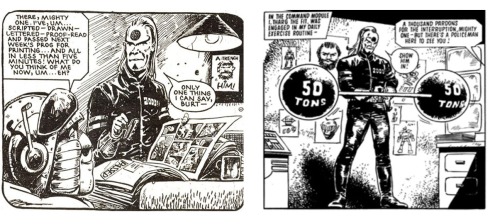
The penultimate appearances of Alec Trench (l-r) Prog 467 & The Sci-Fi Special 1983
Sadly, like heroes from Savage to Defoe, Ichabod Azreal to Judge Dredd, Trench was but human and his removal as icon from Tharg’s fiefdom would be complete by the time of the Murdoch-like move to full colour Progs. One last fleeting reference to our disenfranchised hero would be glimpsed, shorn of his beard and lustre, muddied by 2000AD’s era of brown-paint but still there, grinning out at the droids and readers, letting them know that whenever a true classic of 2000AD is there, a Golden Fox Rebellion, a Trash, a Stalag #666, so too is Alec Trench.
Alec Trench, star of 2000AD, companion of Dr Who, valiant soldier of Darkie’s Mob, wit, raconteur, doubtless father to several illegitimate children, and writer of that great script you never realised was him, Futureshockd salutes you!
(FutureShockd would like to thank the many artists who kept the spirit of Trench alive, Alan Grant for his ambiguous role as public front, W.R. Logan (for his exhaustive history), contributors to the http://forums.2000adonline.com threads on Trench & a research grant from Quaxxann University). If Alec Trench touched your life, be it droid or human, let Futureshockd know.


